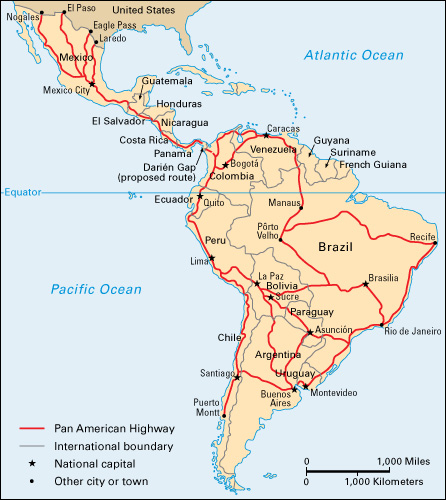Pan American Highway is a system of highways that extends from the United States-Mexican border to southern Chile. It also connects the east and west coasts of South America, and links the capitals of 17 Latin American countries. The 29,525-mile (47,516-kilometer) system benefits Latin America’s economy. It provides a route for raw materials and agricultural products through much of Latin America. The Pan American Highway is sometimes described as running through the western United States and Canada up into Alaska. But neither country has officially named any highway as part of the Pan American Highway system.
Route.
The Pan American Highway has four major U.S. terminals: Nogales, Arizona ; and Eagle Pass, El Paso, and Laredo, Texas. It crosses Mexico, Guatemala, El Salvador, Honduras, Nicaragua, and Costa Rica, and into Panama. The Darien Gap, a stretch of jungle, blocks the highway at Yaviza, Panama. Motorists usually ship their cars from either Cristóbal or Balboa, Panama, to Colombia or Venezuela. South of the gap the highway follows the western coastline of South America to Puerto Montt, Chile.

At Santiago, Chile, about 660 miles (1,060 kilometers) north of Puerto Montt, a major branch of the highway cuts eastward across the Andes Mountains to Buenos Aires, Argentina. From Buenos Aires, it follows the east coast of South America north to Rio de Janeiro, Brazil, then turns inland to Brasília, the capital of Brazil. Other branches of the highway lead to the capitals of Bolivia (La Paz and Sucre), Paraguay (Asunción), and Venezuela (Caracas).
Development.
The idea to link North and South America dates from the late 1800’s, when people talked of building a Pan American railway. But it was not until 1923, at the Fifth International Conference of American States, that a highway was seriously considered. This conference led to the First Pan American Highway Congress at Buenos Aires in 1925.
Organization of the system started in the late 1920’s. By 1940, over 60 per cent of the highway between the United States and Panama had been completed. By the early 1950’s, most of the project was open to travel in South America. An important link in the system opened in 1962, when the Thatcher Ferry Bridge (now called the Bridge of the Americas) was completed over the Panama Canal at Balboa. The bridge is 1 mile (1.6 kilometers) long and is one of the world’s longest steel arch bridges.
Each South American country has financed the building of the highways within its own borders. In 1930, the United States began giving financial support to speed the building of the Pan American Highway between Panama and Texas. This section is also called the Inter-American Highway. The United States has contributed two-thirds of the cost of building this part of the highway. Only Mexico has not used United States financial aid in building the system.
